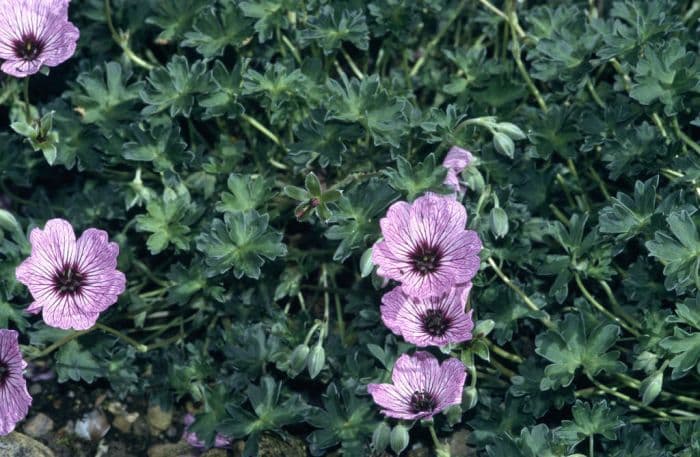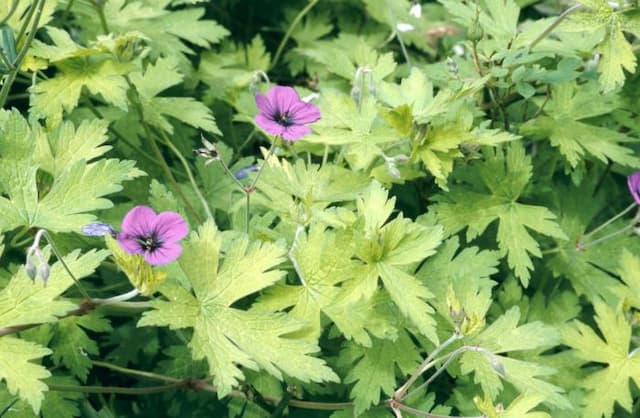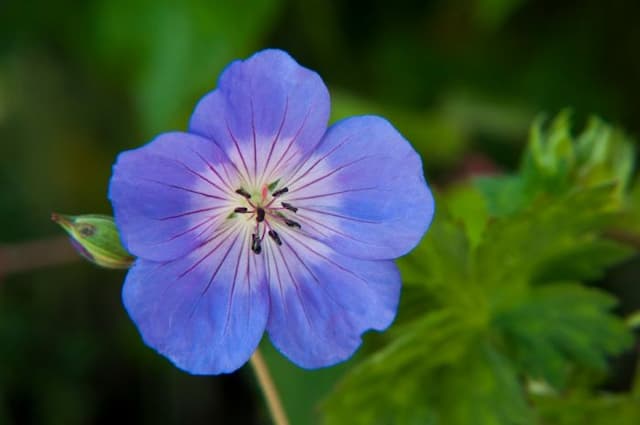Cranesbill Geranium (Cinereum Group) 'Ballerina'

ABOUT
The Geranium 'Ballerina' is an attractive perennial plant known for its ornamental qualities and delightful blooms. It features a dense mound of deeply lobed, rich green foliage that sets the stage for its showy flowers. The leaves might turn to an attractive reddish hue as the cooler weather sets in, giving it added seasonal interest. The flowers of the 'Ballerina' are particularly striking, having pale lilac to pink petals that are delicately veined with a darker hue, often appearing to have a web-like pattern. At the center of each flower, there are contrasting dark purple stamens that add an eye-catching pop of color. The flowers are cup-shaped and typically have five petals, creating a simple yet elegant floral display. During its flowering period, Geranium 'Ballerina' becomes a highlight in the garden as it gets covered in these beautiful blooms, creating a soft, pastel-colored spectacle. Its growth habit makes it a fantastic groundcover or border plant, and it thrives particularly well in rock gardens or similar settings where its charming flowers can be appreciated up close. Its overall appearance is one of delicate beauty, attracting various pollinators, including bees and butterflies, adding life and vitality to its surroundings.
About this plant
 Names
NamesFamily
Geraniaceae
Synonyms
Dusky Cranesbill, Grayleaf Cranesbill
Common names
Geranium cinereum 'Ballerina'.
 Toxicity
ToxicityTo humans
Geraniums, including the Geranium 'Ballerina', are generally considered non-toxic to humans. Accidental ingestion of plant parts may cause mild gastrointestinal discomfort but are not known to have serious toxic effects. Symptoms may include nausea, vomiting, or diarrhea if ingested in significant amounts, but such cases are rare. Always exercise common sense and avoid ingesting plant material.
To pets
Geraniums are typically considered non-toxic to pets as well. However, ingestion can occasionally result in mild gastrointestinal upset for some animals. Symptoms might include vomiting, diarrhea, or loss of appetite if pets consume parts of the plant. It is always prudent to prevent pets from eating plants, as individual sensitivity can vary.
 Characteristics
CharacteristicsLife cycle
Perennials
Foliage type
Semi-deciduous
Color of leaves
Green
Flower color
Pink
Height
6 inches (15 cm)
Spread
12 inches (30 cm)
Plant type
Herb
Hardiness zones
5
Native area
Mediterranean
Benefits
 General Benefits
General Benefits- Attractive Flowers: 'Ballerina' produces delicate pink flowers with attractive purple veins, which add a splash of color to gardens and landscapes.
- Drought Tolerance: Once established, 'Ballerina' has a good level of drought tolerance, making it suitable for xeriscaping or gardens with low water availability.
- Easy Maintenance: This plant requires minimal upkeep beyond occasional deadheading to promote further blooming and prevent self-seeding.
- Pest Resistance: 'Ballerina' is generally resistant to many common garden pests, reducing the need for chemical interventions.
- Rabbit and Deer Resistance: The plant is not a preferred choice for rabbits and deer, which can help minimize browsing damage in gardens frequented by wildlife.
- Long Blooming: 'Ballerina' has a long blooming season, often from late spring to early fall, providing extended visual interest.
- Compact Size: Its compact growth habit makes it suitable for small gardens, rockeries, and container planting where space might be limited.
- Border Planting: With its mounding habit and attractive foliage, 'Ballerina' is an excellent choice for edges and borders, providing structure and color.
- Attracts Pollinators: The flowers of 'Ballerina' attract bees and butterflies, which are beneficial for pollination of surrounding plants.
- Versatile Usage: The plant can be used in various garden styles, including cottage gardens, perennial borders, and alpine gardens.
 Medical Properties
Medical PropertiesThis plant is not used for medical purposes.
 Air-purifying Qualities
Air-purifying QualitiesThis plant is not specifically known for air purifying qualities.
 Other Uses
Other Uses- Artistic Inspiration: The delicate petals and hues of the Geranium can serve as inspiration for artists and designers, influencing color palettes and patterns in their work.
- Photography Subjects: With their intricate details and vivid colors, Geraniums are excellent subjects for macro photography, allowing photographers to capture the subtleties of their beauty.
- Edible Flowers: Although not commonly consumed, the petals of some Geranium species are edible and can be used as a colorful garnish in salads or to decorate desserts.
- Natural Fabric Dye: The vibrant blossoms of the Geranium can be used to create natural dyes for fabrics, yielding a range of pink and purple hues.
- Garden Borders: Geraniums like 'Ballerina' can create stunning and low-maintenance borders in gardens, adding a splash of color along pathways or between other plants.
- Companion Planting: When planted alongside vegetables and other flowers, Geraniums can help deter certain pests, thanks to their strong fragrance.
- Educational Tool: These plants can be used in schools or educational programs to teach children about plant biology, pollination, and the life cycle of flowers.
- Craft Projects: The dried flowers and leaves of Geraniums can be incorporated into craft projects such as homemade potpourri, pressed flower art, or natural confetti.
- Floral Arrangements: Geraniums can add a unique touch to floral arrangements with their distinct shape and color, providing variety and texture.
- Culinary Experiments: Some adventurous chefs may experiment with the leaves of scented Geraniums to infuse sugars or syrups with their aromatic properties for use in creative cuisine.
Interesting Facts
 Feng Shui
Feng ShuiGeraniums are often used in Feng Shui to promote positive energy and to uplift the mood within a home. Their bright and colorful flowers are believed to attract good chi and can be placed in areas of the home that require a burst of energy or where you want to encourage vitality and happiness, such as living spaces or near the front entrance. However, because the 'Ballerina' geranium is not specifically referenced in traditional Feng Shui, general practices related to the use of geraniums would apply.
 Zodiac Sign Compitability
Zodiac Sign CompitabilityThe geranium is not used in astrology practice.
 Plant Symbolism
Plant Symbolism- Fertility: Geraniums are often associated with fertility due to their abundant and lush blooms.
- Health and Longevity: The geranium is believed to promote health and long life, which may be attributed to its hardy nature and ability to thrive with basic care.
- Happiness: With their bright and cheerful flowers, geraniums symbolize happiness and positive emotions.
- Friendship: Giving a geranium can be a gesture of kindness and is often seen as a symbol of close friendship and good wishes.
- Peace: The geranium flower is thought to bring peace and calm to a situation, making it a good choice for a gift in times of stress or recovery.
 Water
WaterFor the Hardy Geranium 'Ballerina', water the plant deeply once a week, allowing the top inch of soil to dry out between waterings. During periods of high heat or drought, you may need to water more frequently, but avoid overwatering to prevent root rot. A good approach is to provide about one gallon of water per square foot every week, adjusting as necessary for weather conditions and the plant's response.
 Light
LightHardy Geranium 'Ballerina' thrives best in full sun to partial shade. It should be planted in a location where it can receive at least 4 to 6 hours of sunlight daily. However, in very hot climates, providing some afternoon shade will help protect the plant from intense heat.
 Temperature
TemperatureHardy Geranium 'Ballerina' prefers moderate temperatures and can generally tolerate temperatures as low as 20°F and as high as 80°F. The ideal growing temperature for this plant is between 60°F and 70°F. Hardy Geranium 'Ballerina' is resilient but should be protected from extreme cold and heat whenever possible.
 Pruning
PruningPrune Hardy Geranium 'Ballerina' to remove dead or faded flowers and encourage a second bloom in late summer or early fall. Pruning can be done lightly throughout the growing season to maintain shape and encourage new growth. The best time for more extensive pruning is in late autumn or early spring to prepare for new growth.
 Cleaning
CleaningAs needed
 Soil
SoilThe ideal soil mix for Geranium 'Ballerina' should be well-draining and fertile with a mix of loam, peat, and sand or perlite. The soil pH should be slightly acidic to neutral, ranging from 5.8 to 7.2.
 Repotting
RepottingGeranium 'Ballerina' doesn't require frequent repotting and should be repotted every 2-3 years or when the pot becomes root-bound.
 Humidity & Misting
Humidity & MistingGeranium 'Ballerina' prefers moderate humidity levels but is adaptable to typical household humidity conditions.
 Suitable locations
Suitable locationsIndoor
Place in bright indirect light, allow soil to dry slightly between waterings.
Outdoor
Plant in full sun to partial shade, in well-drained soil.
Hardiness zone
5-8 USDA
 Life cycle
Life cycleThe life cycle of the Geranium 'Ballerina' begins with seed germination, typically in the spring, where warmth and moisture stimulate the seed to sprout and form a small seedling. As the seedling grows, it develops a rosette of leaves at the ground level and establishes a root system. This perennial plant then enters the vegetative stage, where it focuses on leaf and stem growth in preparation for flowering. Flowering generally occurs in late spring to early summer, showcasing its distinctive light pink flowers with dark purple veining. After pollination, often aided by insects, the plant sets seed, which can either be collected for propagation or allowed to self-sow if conditions are favorable. During fall and winter, the above-ground parts of the Geranium 'Ballerina' may die back, but the plant can survive with its root system and regrow the following spring, completing its cycle.
 Propogation
PropogationPropogation time
Spring-Early Summer
The Geranium (Cinereum Group) 'Ballerina', commonly referred to as the Cranesbill 'Ballerina', can be effectively propagated through the division of its clumps. The best time for this is either in the spring or autumn when the plant is not in peak bloom. To propagate by division, carefully dig up the entire plant, making sure to maintain a good amount of soil around the roots. Using a sharp knife or spade, split the clump into smaller sections, each with a decent root system and several shoots. Replant the divisions at the same depth they were growing at previously, spacing them about 12 to 18 inches (approximately 30 to 45 centimeters) apart to allow for growth. Water the new plantings thoroughly to establish them in their new location. This method allows gardeners to quickly expand their cranesbill collections and fill in garden spaces with these delicate blooms.









